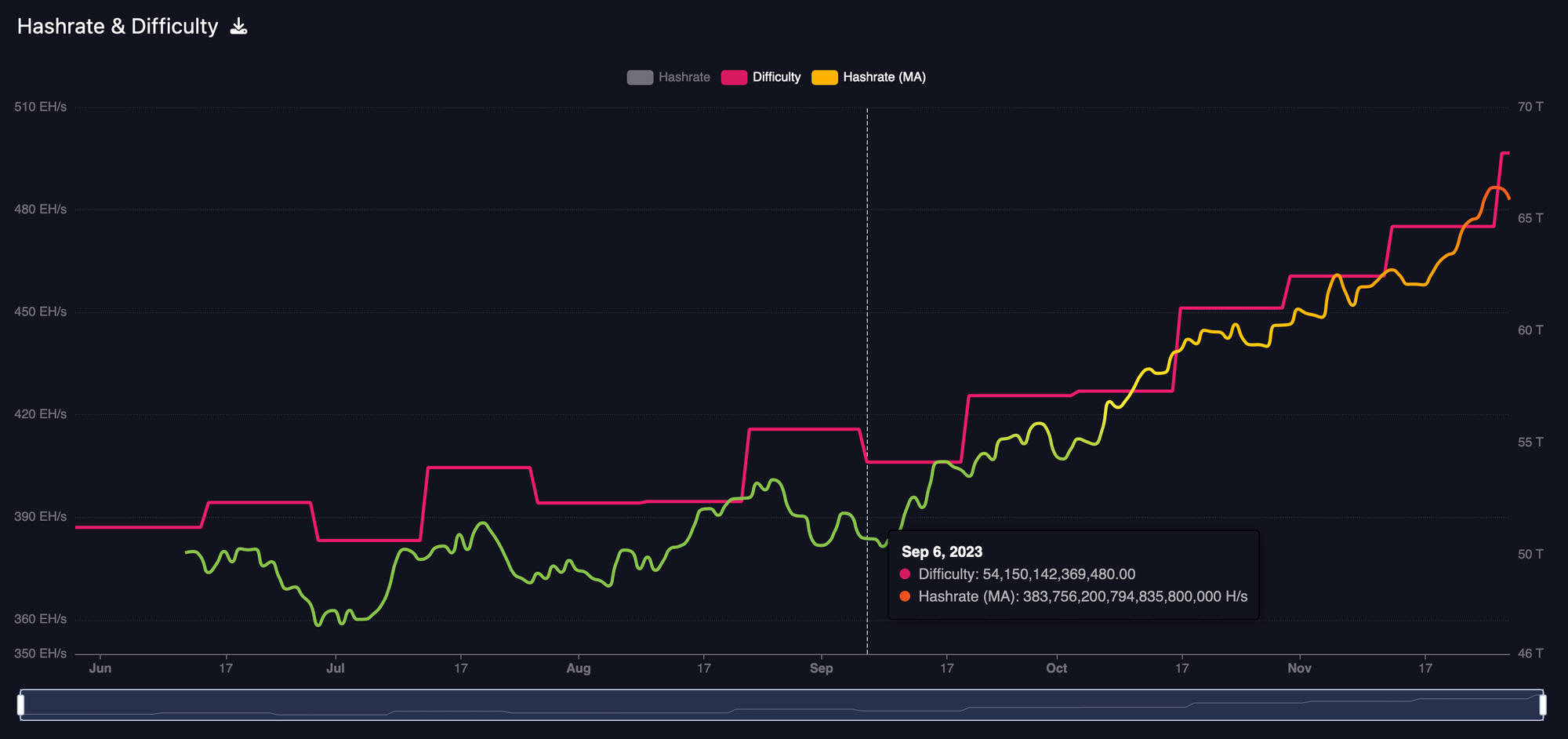

Even though a 27% increase in hashrate in less than three months may seem insane, you ain't seen nothing yet.
The amount of hashrate that has come on the bitcoin network since early September has been pretty astonishing. On September 5th there was a downward difficulty adjustment of 2.65%, the overall network hashrate estimates were hovering around 383EH/s and difficulty was around 54.150 TRILLION (meaning that, statistically speaking, at least 54,150,142,369,480 hashes would need to be produced by miners to find a valid hash below the difficulty target at that time).

Since then, the network has experienced six consecutive upwards difficulty adjustments, with the latest being an upwards adjustment of 5.07%. These upwards difficulty adjustments were the result of network hashrate growing by almost 27% to 486.5EH/s.
A new difficulty all time high. There have been 6 consecutive upwards difficulty adjustments since early September.
— TFTC (@TFTC21) November 26, 2023
Driven miners staying online as the temperature cools, bitcoin's price pump making older generation models profitable again, and new miners getting plugged in. https://t.co/x0g84unp9H pic.twitter.com/IoNR9jyzAk
To put this another way, the amount of hashrate that has come on the network in less than three months is more than a quarter of the total hashrate that came on the network over the course of the first fourteen years and eight months since the network launched on January 3rd, 2009. Pretty mind boggling to consider when you take a step back to think about it.
The question this raises is, "What is driving this rapid growth in network hashrate?" The answer to this question is multi-faceted. Here are a list of things I can think of that would be driving this hashrate growth.
The Summer months are peak demand months for grids located in hotter climates. When the temperature rises, demand on the grid increases significantly and miners engaged in demand response programs are forced to power down their miners for hours at a time so that they can send electricity back to the grid so that residential consumers can keep their air conditioners on. This creates a lot of intra-day hashrate variability that perturbs block production. The end of Summer brings with it cooler temperatures and less hashrate variability. This demand-response driven variability is likely as pronounced as it has ever been in bitcoin's history because of the amount of hashrate that is located in Texas, which has notoriously hot Summers and an increasing amount of stress on its grid due to all of the individuals and businesses that have relocated to the Lone Star State. As we get into the middle of Fall, there is less need for demand response, so miners have likely increased their uptime materially compared to the Summer months, which will affect overall hashrate calculations.
Miner profitability is driven predominately by three things; the cost of their electricity, the price of bitcoin at any given point in time, and the machines they are running. As bitcoin's price has appreciated and demand for blockspace has risen - driving up the average amount of fees collected by miners in each block - the bitcoin hashprice has risen off the floor of ~$0.06 in the middle of Summer to ~$0.076 right now. Reaching ~$0.095 a ten days ago. Hashprice rising by 25-58% means that some miners that were unprofitable at a hashprice of $0.06 are now profitable and have likely turned back on, maybe even temporarily, to take advantage of the current mining conditions. Previously unprofitable miners turning back on will drive hashrate higher, even if marginally.
The main driver of this hashrate growth is most likely the fact that some of the newer generation miners that were sitting on the sidelines either waiting for infrastructure to get built out before getting plugged in or because they simply weren't being purchased are currently being plugged in and turned on. This is being driven by a combination of mining operations getting funded and/or electrified, and ASIC manufacturers attempting to monetize their inventory by plugging as much as possible in. Since the batches of miners that are being delivered to mining operations or were sitting idle in the inventory of manufacturers are the most efficient and highest hashing machines, plugging them in en masse will have a material effect on overall hashrate. From what I can gather, a lot of players are plugging in a lot of the latest s19 XP series. It also can't be ruled out that Bitmain is plugging in some of the early batches of their S21 series before selling them to miners to bolster their revenues. If that is the case, the 27% jump in hashrate isn't that surprising since the S21 air cooled model is 18.6% more energy efficient while producing 43% more hashrate than the S19 XP air cooled model.
One thing that certainly can't be ruled out is that more nation states have entered the hash race. Earlier this year we learned that Russia, the Kingdom of Bhutan, and Oman have skin in the mining game. It would be naive to think that others didn't receive that signal and start reacting accordingly. It is probably safe to assume that all three of those countries have added to their mining fleets as the price has increased and they have become somewhat competent operators and that others have joined the fray.
Even though a 27% increase in hashrate in less than three months may seem insane, you ain't seen nothing yet.
Final thought...
Sometimes I wish it didn't take me until 10PM at night to get into a writing flow. But it is also pretty sweet once I'm in it.


